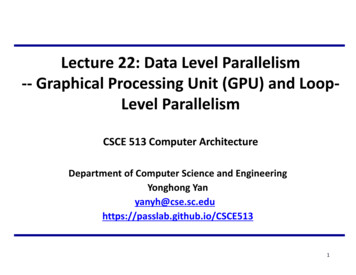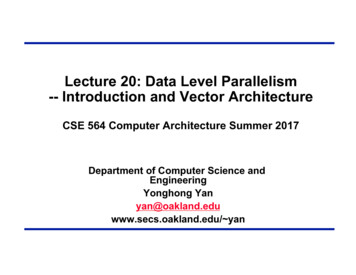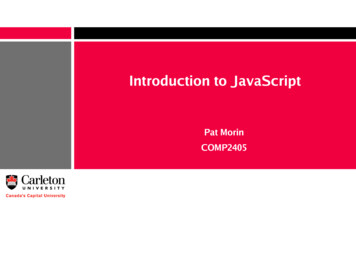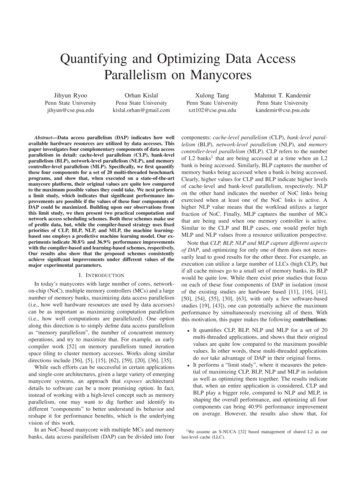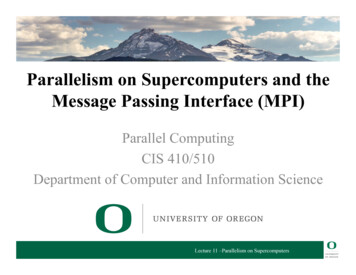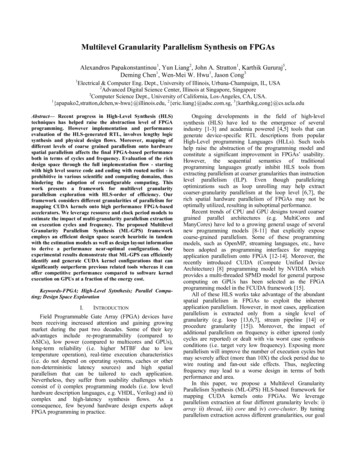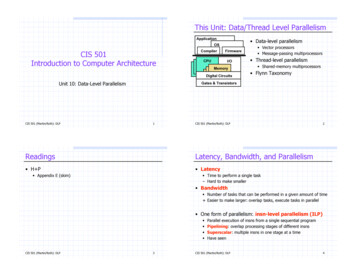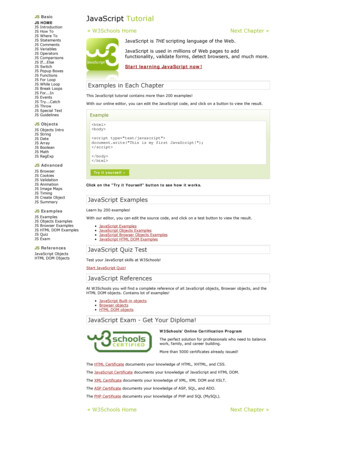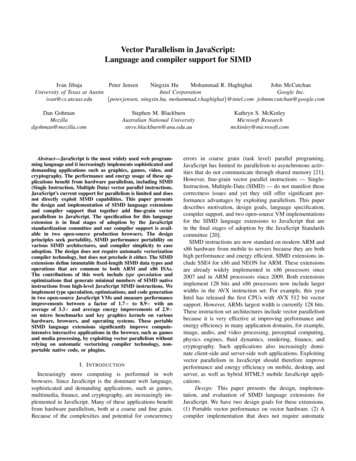
Transcription
Vector Parallelism in JavaScript:Language and compiler support for SIMDIvan JibajaPeter JensenNingxin HuMohammad R. HaghighatJohn McCutchanUniversity of Texas at AustinIntel CorporationGoogle Inc.ivan@cs.utexas.edu{peter.jensen, ningxin.hu, mohammad.r.haghighat}@intel.com johnmccutchan@google.comDan GohmanMozilladgohman@mozilla.comStephen M. BlackburnAustralian National aScript is the most widely used web programming language and it increasingly implements sophisticated anddemanding applications such as graphics, games, video, andcryptography. The performance and energy usage of these applications benefit from hardware parallelism, including SIMD(Single Instruction, Multiple Data) vector parallel instructions.JavaScript’s current support for parallelism is limited and doesnot directly exploit SIMD capabilities. This paper presentsthe design and implementation of SIMD language extensionsand compiler support that together add fine-grain vectorparallelism to JavaScript. The specification for this languageextension is in final stages of adoption by the JavaScriptstandardization committee and our compiler support is available in two open-source production browsers. The designprinciples seek portability, SIMD performance portability onvarious SIMD architectures, and compiler simplicity to easeadoption. The design does not require automatic vectorizationcompiler technology, but does not preclude it either. The SIMDextensions define immutable fixed-length SIMD data types andoperations that are common to both ARM and x86 ISAs.The contributions of this work include type speculation andoptimizations that generate minimal numbers of SIMD nativeinstructions from high-level JavaScript SIMD instructions. Weimplement type speculation, optimizations, and code generationin two open-source JavaScript VMs and measure performanceimprovements between a factor of 1.7 to 8.9 with anaverage of 3.3 and average energy improvements of 2.9 on micro benchmarks and key graphics kernels on varioushardware, browsers, and operating systems. These portableSIMD language extensions significantly improve computeintensive interactive applications in the browser, such as gamesand media processing, by exploiting vector parallelism withoutrelying on automatic vectorizing compiler technology, nonportable native code, or plugins.I. I NTRODUCTIONIncreasingly more computing is performed in webbrowsers. Since JavaScript is the dominant web language,sophisticated and demanding applications, such as games,multimedia, finance, and cryptography, are increasingly implemented in JavaScript. Many of these applications benefitfrom hardware parallelism, both at a coarse and fine grain.Because of the complexities and potential for concurrencyKathryn S. McKinleyMicrosoft Researchmckinley@microsoft.comerrors in coarse grain (task level) parallel programing,JavaScript has limited its parallelism to asynchronous activities that do not communicate through shared memory [21].However, fine-grain vector parallel instructions — SingleInstruction, Multiple-Data (SIMD) — do not manifest thesecorrectness issues and yet they still offer significant performance advantages by exploiting parallelism. This paperdescribes motivation, design goals, language specification,compiler support, and two open-source VM implementationsfor the SIMD language extensions to JavaScript that arein the final stages of adoption by the JavaScript Standardscommittee [20].SIMD instructions are now standard on modern ARM andx86 hardware from mobile to servers because they are bothhigh performance and energy efficient. SIMD extensions include SSE4 for x86 and NEON for ARM. These extensionsare already widely implemented in x86 processors since2007 and in ARM processors since 2009. Both extensionsimplement 128 bits and x86 processors now include largerwidths in the AVX instruction set. For example, this yearIntel has released the first CPUs with AVX 512 bit vectorsupport. However, ARMs largest width is currently 128 bits.These instruction set architectures include vector parallelismbecause it is very effective at improving performance andenergy efficiency in many application domains, for example,image, audio, and video processing, perceptual computing,physics engines, fluid dynamics, rendering, finance, andcryptography. Such applications also increasingly dominate client-side and server-side web applications. Exploitingvector parallelism in JavaScript should therefore improveperformance and energy efficiency on mobile, desktop, andserver, as well as hybrid HTML5 mobile JavaScript applications.Design: This paper presents the design, implementation, and evaluation of SIMD language extensions forJavaScript. We have two design goals for these extensions.(1) Portable vector performance on vector hardware. (2) Acompiler implementation that does not require automatic
2vectorization technology to attain vector performance. Thefirst goal helps developers improve the performance of theirapplications without unpleasant and unexplainable performance surprises on different vector hardware. The secondgoal simplifies the job of realizing vector performance inexisting and new JavaScript Virtual Machines (VMs) andcompilers. Adding dependence testing and loop transformation vectorizing technology is possible, but our designand implementation do not require it to deliver vectorperformance.This paper defines SIMD language extensions and newcompiler support for JavaScript. The language extensionsconsist of fixed-size immutable vectors and vector operators,which correspond to hardware instructions and vector sizescommon to ARM and x86. The largest size common toboth is 128 bits. Although an API with variable or largersizes (e.g., Intel’s AVX 512-bit vectors) may seem appealing,correctly generating code that targets shorter vector instructions from longer ones violates our vector performanceportability design goal. For example, correctly shorteningnon-streaming vector instructions, such as shuffle/swizzle,requires generating scalar code that reads all values outand then stores them back, resulting in scalar performanceinstead of vector performance on vector hardware.We define new SIMD JavaScript data types (e.g. Int32x4,Float32x4), constructors, lane accessors, operators (arithmetic, bitwise operations, comparisons, and swizzle/shuffle),and typed array accessors and mutators for these types. Toease the compiler implementation, most of these SIMD operations correspond directly to SIMD instructions commonto the SSE4 and NEON extensions. We choose a subsetthat improve a wide selection of sophisticated JavaScriptapplications, but this set could be expanded in the future.This JavaScript language specification was developed incollaboration with Google for the Dart programming language, reported in a workshop paper [14]. The Dart andJavaScript SIMD language specifications are similar in spirit.The language extensions we present are in the final stagesof approval by the ECMAScript standardization committee(Ecma TC39) [20].Type Speculation: We introduce type speculation, amodest twist on type inference and specialization for implementing these SIMD language extensions. For every methodcontaining SIMD operations, the Virtual Machine’s Just-inTime (JIT) compiler immediately produces SIMD instructions for those operations. The JIT compiler speculates thatevery high-level SIMD instruction operates on the specifiedSIMD type. It translates the code into an intermediateform, optimizes it, and generates SIMD assembly. In mostcases, it produces optimal code with one or two SIMDassembly instructions for each high-level SIMD JavaScriptinstruction. The code includes guards that check for nonconforming types that reverts to unoptimized code whenneeded. In contrast, modern JIT compilers for dynamiclanguages typically perform some mix of type inference,which uses static analysis to prove type values and eliminateany dynamic checks, and type feedback, which observescommon types over multiple executions of a method andthen optimizes for these cases, generating guards for nonconforming types [1, 11]. Our JIT compilers instead willuse the assumed types of the high-level SIMD instructionsas hints and generate code accordingly.Implementation: We implement and evaluate this compiler support in two JavaScript Virtual Machines (V8 andSpiderMonkey) and generate JIT-optimized SIMD instructions for x86 and ARM. Initially, V8 uses a simple JITcompiler (full codegen) to directly emit executable code [7],whereas SpiderMonkey uses an interpreter [6, 18]. Both willdetect hot sections and later JIT compilation stages will perform additional optimizations. We add JIT type speculationand SIMD optimizations to both Virtual Machines (VMs).Our JIT compiler implementations include type speculation,SIMD method inlining, SIMD type unboxing, and SIMDcode generation to directly invoke the SIMD assemblyinstructions. When the target architecture does not containSIMD instructions or the dynamic type changes from theSIMD class to some other type, SpiderMonkey currentlyfalls back on interpretation and V8 generates deoptimized(boxed) code.Benchmarks: For any new language features, we mustcreate benchmarks for evaluation. We create microbenchmarks by extracting ten kernels from common applicationdomains. These kernels are hot code in these algorithms thatbenefit from vector parallelism. In addition, we report resultsfor one application, skinning, a key graphics algorithm thatassociates the skin over the skeleton of characters from avery popular game engine. We measure the benchmarkson five different Intel CPUs (ranging from an Atom to ani7), and four operating systems (Windows, Unix, OS X,Android). The results show that SIMD instructions improveperformance by a factor of 3.4 on average and improveenergy by 2.9 on average. SIMD achieves super-linearspeed ups in some benchmarks because the vector versionsof the code eliminate intermediate operations, values, andcopies. On the skinning graphics kernel, we obtain a speedupof 1.8 .Artifact: The implementations described in this paperare in Mozilla Firefox Nightly builds and in submissionto Chromium. We plan to generate optimized scalar codefor machines that lack SIMD instructions in future work.This submission shows that V8 and SpiderMonkey cansupport SIMD language extensions without performing sophisticated dependence testing or other parallelism analysis or transformations, i.e., they do not require automaticvectorization compiler technology. However, our choicedoes not preclude such sophisticated compiler support, orpreprocessor/developer-side vectorization support in toolssuch as Emscripten [17], or higher level software abstrac-
3tions that target larger or variable size vectors, as applicable,to further improve performance. By adding portable SIMDlanguage features to JavaScript, developers can exploit vector parallelism to make demanding applications accessiblefrom the browser. We expect that these substantial performance and energy benefits will inspire a next generation ofJIT compiler technology to further exploit vector parallelism.Contributions: This paper presents the design andimplementation of SIMD language extensions and compilersupport for JavaScript. No other high level language has provided direct access to SIMD performance in an architectureindependent manner. The contributions of this paper are asfollows:1) a language design justified on the basis of portabilityand performance;2) compiler type speculation without profiling in a dynamic language; and3) the first dynamic language with SIMD instructions thatdeliver their performance and energy benefits.II. BACKGROUND AND R ELATED W ORKWestinghouse was the first to investigate vector parallelism in the early 1960s, envisioning a co-processor formathematics, but cancelled the effort. The principal investigator, Daniel Slotnick, then left and joined University ofIllinois, where he lead the design of the ILLIAC IV, thefirst supercomputer and vector machine [3]. In 1972, it was13 times faster than any other machine at 250 MFLOPSand cost 31 million to build. CRAY Research went on tobuild commercial vector machines [4] and researchers at Illinois, CRAY, IBM, and Rice University pioneered compilertechnologies that correctly transformed scalar programs intovector form to exploit vector parallelism.Today, Intel, AMD, and ARM processors for servers,desktop, and mobile offer coarse-grain multicore and finegrain vector parallelism with Single Instruction MultipleData (SIMD) instructions. For instance, Intel introducedMMX instructions in 1997, the original SSE (StreamingSIMD Extensions) instructions in 1999, and its latest extension, SSE4, in 2007 [9, 10]. All of the latest AMD andIntel machines implement SSE4.2.ARM implements vectorparallelism with its NEON SIMD instructions, which areoptional in Cortex-A9 processors, but standard in all CortexA8 processors.The biggest difference between vector instruction sets inx86 and ARM is vector length. The AVX-512 instructionset in Intel processors defines vector lengths up to 512 bits.However, NEON defines vector lengths from 64-bit up to128-bit. To be compatible with both x86 and ARM vectorarchitectures and thus attain vector-performance portability,we choose one fixed-size 128-bit vector length, since it is thelargest size that both platforms support. Choosing a largeror variable size than all platforms support is problematicwhen executing on machines that only implement a shortervector size because some long SIMD instructions can onlybe correctly implemented with scalar instructions on shortervector machines. See our discussion below for additionaldetails. By choosing the largest size all platforms support,we avoid exposing developers to unpleasant and hard todebug performance degradations on vector hardware. Wechoose a fixed size that all architectures support to deliverperformance portability on all vector hardware.Future compiler analysis could generate code for widervector instructions to further improve performance, althoughthe dynamically typed JavaScript setting makes this taskmore challenging than, for example, in Fortran compilers.We avoided a design choice that would require significantcompiler support because of the diversity in JavaScriptcompiler targets, from embedded devices to servers. Ourchoice of a fixed-size vector simplifies the programminginterface, compiler implementation, and guarantees vectorperformance on vector hardware. Supporting larger vectorsizes could be done in a library with machine-specific hooksto attain machine-specific benefits on streaming SIMD operations, but applications would suffer machine-specific performance degradations for non-streaming operations, suchas shuffle, because the compiler must generate scalar codewhen an architecture supports only the smaller vector sizes.Both SSE4 and NEON define a plethora of SIMD instructions, many more than we currently propose to include inJavaScript. We choose a subset for simplicity, selecting operations based on an examination of demanding JavaScript applications, such as games. Most of our proposed JavaScriptSIMD operations map directly to a hardware SIMD instruction. We include a few operations, such as shuffleMix(also known as swizzle), that are not directly implementedin either architecture, but are important for the JavaScriptapplications we studied. For these operations, the compilergenerates two or three SIMD instructions, rather than justone. The current set is easily extended.Intel and ARM provide header files which define SIMDintrinsics for use in C/C programs (xmmintrin.h andarm neon.h, respectively). These intrinsics directly mapto each SIMD instruction in the hardware, thus there arecurrently over 400 intrinsic functions [10]. Similarly, ARMimplements NEON intrinsics for C and C [2]. Theseplatform-specific intrinsics result in architecture-dependentcode, thus using either one directly in JavaScript is notdesirable nor an option for portable JavaScript code.Managed languages, such as Java and C#, historically onlyprovide access to SIMD instructions through their nativeinterfaces, JNI (Java Native Interface) and C library in thecase of Java and C# respectively, which use the SIMD intrinsics. However, recently Microsoft and the C# Mono projectannounced a preliminary API for SIMD programming for.NET [15, 16]. This API is directly correlated to the setof SSE intrinsics, which limits portability across differentSIMD instruction sets. In C#, the application can query the
4hardware to learn the maximum vector length and versionof the SSE standard on the architecture. This API resultsin architecture-specific code embedded in the application, isnot portable, and is thus not appropriate for JavaScript.Until now, dynamic scripting languages, such as PHP,Python, Ruby, Dart, and JavaScript, have not included SIMDsupport in their language specification. We analyzed theapplication space and chose the operations based on theirpopularity in the applications and their portability across theSSE3, SSE4.2, AVX, and NEON SIMD instruction sets. Weobserved a few additional SIMD patterns that we standardizeas methods, which the JIT compiler translates into multipleSIMD instructions.III. D ESIGN R ATIONALEOur design is based on fixed-width 128-bit vectors. Anumber of considerations influenced this decision, includingthe programmer and the compiler writer.A fixed vector width offers simplicity in the form of consistent performance and consistent semantics across vectorarchitectures. For example, the number of times a loop iterates is not affected by a change in the underlying hardware.A variable-width vector or a vector width larger than thehardware supports places significant requirements on the JITcompiler. Given the variety of JavaScript JIT VMs and thediverse platforms they target, requiring support for variablewidth vectors was considered unviable. Additionally, variable width vectors cannot efficiently implement some important algorithms (e.g. matrix multiplication, matrix inversion,vector transform). On the other hand, developers are free toadd more aggressive JIT compiler functionality that exploitswider vectors if the hardware provides them. Another consideration is that JavaScript is heavily used as a compilertarget. For example, Emscripten compiles from C/C [? ],and compatibility with mmintrin.h offered by our fixedwidth vectors is a bonus.Finally, given the decision to support fixed width vectors,we selected 128 bits because it is the widest vector supportedby all major architectures today. Not all instructions canbe decomposed to run on a narrower vector instruction.For example, non-streaming operations, such as the shuffleinstruction, in general cannot utilize the SIMD hardwareat all when the hardware is narrower than the software.For this reason, we chose the largest common denominator.Furthermore, 128 bits is a good match to many importantalgorithms, such as single-precision transformations overhomogeneous coordinates in computer graphics (XYZW)and algorithms that manipulate the RGBA color space.IV. L ANGUAGE S PECIFICATIONThis section presents the SIMD data types, operations,and JavaScript code samples. The SIMD language extensions give direct control to the programmer and requirevery simple compiler support, but still guarantees vectorperformance when the hardware supports SIMD instructions. Consequently, most of the JavaScript SIMD operationshave a one-to-one mapping to common hardware SIMDinstructions. This section includes code samples for the mostcommon data types. The full specification is available online [20].A. Data TypesWe add the following three new fixed-width 128-bitnumeric value types to ithwithwithwithwithwithwithwithwithwithfour 32-bit single-precision floatsfour 32-bit signed integers8 16-bit signed integers16 8-bit signed integers4 32-bit unsigned integers8 16-bit unsigned integers16 8-bit unsigned integers4 boolean values8 boolean values16 boolean valuesFigure 1 shows the simple SIMD type hierarchy. Each SIMDtypes has four to sixteen lanes, which correspond to degreesof SIMD parallelism. Each element of a SIMD vector is alane. Indices are required to access the lanes of vectors. Forinstance, the following code declares and initializes a SIMDsingle-precision float and assigns 3.0 to a.var V1 SIMD.Float32x4 (1.0, 2.0, 3.0, 4.0);var a SIMD.Float32x4.extractLan(V1,3);Figure 1: SIMD Type HierarchyB. OperationsConstructors: The type defines the following constructors for all of the SIMD types. The default constructorinitializes each of the two or four lanes to the specifiedvalues, the splat constructor creates a constant-initializedSIMD vector, as follows.var c SIMD.Float32x4(1.1, 2.2, 3.3, 4.4);// Float32x4(1.1, 2.2, 3.3, 4.4)var b SIMD.Float32x4.splat(5.0);// Float32x4(5.0, 5.0, 5.0, 5.0)
5Accesssors and Mutators: The proposed SIMD standard provides operations for accessing and mutating SIMDvalues, and for creating new SIMD values from variationson existing values.extractLane Access one of the lanes of a SIMD value.replaceLane Create a new instance with the value changefor the specified lane.selectCreate a new instance with selected lanesfrom two SIMD values.swizzleCreate a new instance from another SIMDvalue, shuffling lanes.shuffleCreate a new instance by shuffling from thefirst SIMD value into the XY lanes and fromthe second SIMD value into the ZW lanes.These operations are straightforward and below we show afew examples.var a SIMD.Float32x4(1.0, 2.0, 3.0, 4.0);var b a.x; // 1.0var c SIMD.Float32x4.replaceLane(1, 5.0);// Float32x4(5.0, 2.0, 3.0, 4.0)var d SIMD.Float32x4.swizzle(a, 3, 2, 1, 0);// Float32x4(4.0, 3.0, 2.0, 1.0)var f SIMD.Float32x4(5.0, 6.0, 7.0, 8.0);var g SIMD.Float32x4.shuffle(a, f, 1, 0, 6, 7);// Float32x4(2.0, 1.0, 7.0, 8.0)Arithmetic: The language extension supports the following thirteen arithmetic operations over SIMD values:add, sub, mul, div, abs, max, min, sqrt, reciprocalApproximation, reciprocalSqrtApproximation, neg, clamp,scale, minNum, maxNumWe show a few examples below.var a SIMD.Float32x4(1.0, 2.0, 3.0, 4.0);var b SIMD.Float32x4(4.0, 8.0, 12.0, 16.0);var c SIMD.Float32x4.add(a,b);// Float32x4(5.0, 10.0, 15.0, 20.0)var e SIMD.reciprocalSqrtApproximation(d);// Float32x4(0.5, 0.5, 0.5, 0.5);var f SIMD.scale(a, 2);// Float32x4(2.0, 4.0, 6.0, 8.0);var lower SIMD.Float32x4(-2.0, 5.0, 1.0, -4.0);var upper SIMD.Float32x4(-1.0, 10.0, 8.0, 4.0);var g SIMD.Float32x4.clamp(a, lower, upper);// Float32x4(-1.0, 5.0, 3.0, 4.0)Bitwise Operators: The language supports the following four SIMD bitwise operators: and, or, xor, notBit Shifts: We define the following logical andarithmetic shift operations and then show some examples: shiftLeftByScalar, alarvar a SIMD.Int32x4(6, 8, 16, 1);var b SIMD.Int32x4.shiftLeftByScalar(a,1);// Int32x4(12, 16, 32, 2)var c SIMD.Int32x4.shiftRightLogicalByScalar(a, 1);// Int32x4(3, 4, 8, 0)Comparison: We define three SIMD comparisonoperators that yield SIMD boolean values where 0xFand 0x0 represent true and false respectively: equal,notEqual, greaterThan, lessThan, lessThanOrEqual,greaterThanOrEqualvar a SIMD.Float32x4(1.0, 2.0, 3.0, 4.0);var b SIMD.Float32x4(0.0, 3.0, 5.0, 2.0);var gT SIMD.Float32x4.greaterThan(a, b);// Float32x4(0xF, 0x0, 0x0, 0xF);Type Conversion: We define type conversion fromfloating point to integer and bit-wise conversion (i.e., producing an integer value from the floating point bit representation): fromInt32x4, fromFloat32x4, fromFloat64x2,fromInt32x4Bits, fromFloat32x4Bits, fromFloat64x2Bitsvar a SIMD.Float32x4(1.1, 2.2, 3.3, 4.4)var b SIMD.Int32x4.fromFloat32x4(a)// Int32x4(1, 2, 3, 4)var c SIMD.Int32x4.fromFloat32x4Bits(a)// Int32x4(1066192077, 1074580685, 1079194419,1082969293)Arrays: We introduce load and store operations forJavaScript typed arrays for each base SIMD data type thatoperates with the expected semantics. An example is to passin a Uint8Array regardless of SIMD type, which is usefulbecause it allows the compiler to eliminate the shift in goingfrom the index to the pointer offset. The extracted SIMDtype is determined by the type of the load operation.var a new Float32Array(100);for (var i 0, l a.length; i) {a[i] i;}for (var j 0; j a.length; j 4) {sum4 SIMD.Float32x4.add(sum4,SIMD.Float32x4.load(a, j));}var result .Float32x4.extractLane(sum4,0) 1) 2) 3);Figure 2 depicts how summing in parallel reduces thenumber of sum instructions by a factor of the width of theSIMD vector, in this case four, plus the instructions neededto sum the resulting vector. Given a sufficiently long arrayand appropriate JIT compiler technology, the SIMD versionreduces the number of loads and stores by about 75%.This reduction in instructions has the potential to improveperformance significantly in many applications.1.0 2.0 3.0 3.0 5.0 7.0 7.0 6.0 11.0 7.0 8.0 15.0 17.0 16.0 18.0 24.0 75.0 Figure 2: Visualization of averagef32x4 summing inparallel.V. C OMPILER I MPLEMENTATIONSWe add compiler optimizations for SIMD instructions toFirefox’s SpiderMonkey VM [6, 18] and Chromium’s V8
6Figure 3: V8 Engine Architecture.VM [7]. We first briefly describe both VM implementations and then describe our type speculation, followed byunboxing, inlining, and code generation that produce SIMDassembly instructions.SpiderMonkey: We modified the open-source SpiderMonkey VM, used by the Mozilla Firefox browser. SpiderMonkey contains an interpreter that executes unoptimizedJavaScript bytecodes and a Baseline compiler that generatesmachine code. The interpreter collects execution profiles andtype information [18]. Frequently executed JS functions,as determined by the profiles collected by the interpreter,are compiled into executable instructions by the Baselinecompiler. The Baseline compiler mostly generates calls intothe runtime and relies on inline caches and hidden classesfor operations such as property access, function calls, arrayindexing operations, etc. The Baseline compiler also insertscode to collect execution profiles for function invocationsand to collect type information. If a function is found to behot, the second compiler is invoked. This second compiler,called IonMonkey, is an SSA-based optimizing compiler,which uses the type information collected from the inlinecache mechanism to inline the expected operations, therebyavoiding the call overhead into the runtime. IonMonkeythen emits fast native code translations of JavaScript. Weadded SIMD support in the runtime. Instead of waiting forthe runtime to determine whether the method is hot, weperform type speculation and optimizations for all methodsthat contain SIMD operations. We modify the interpreter,the Baseline compiler code generator, and the IonMonkeyJIT compiler. We add inlining of SIMD operations to theIonMonkey compiler. We modify the register allocator andbailout mechanism to support 128-bit values.V8: We also modified the open-source V8 VM,used by the Google Chromium browser. Figure 3 showsthe V8 Engine Architecture. V8 does not interpret. Ittranslates the JavaScript AST (abstract syntax tree) intoexecutable instructions and calls into the runtime whencode is first executed, using the Full Codegen compiler.Figure 4 shows an example of the non-optimized codefrom this compiler. This compiler also inserts profilingand calls to runtime support routines. When V8 detectsa hot method, the Crankshaft compiler translates intoan SSA form. It uses the frequency and type profileinformation to perform global optimizations across basicblocks such as type specialization, inlining, global valuenumbering, code hoisting, and register allocation. Wemodify the runtime to perform type speculation when itdetects methods with SIMD instructions, which invokesthe SIMD compiler support. We added SIMD supportto both the Full Codegen compiler and the Crankshaftcompiler. For the Full Codegen compiler, the SIMD supportis provided via calls to runtime functions implemented inC , as depicted in Figure 4. We modified the Crankshaftcompiler, adding support for inlining, SIMD registerallocation, and code generation which produces optimalSIMD code sequence and vector performance in many cases.Both compilers use frequency and type profiling to inlineand then perform type specialization on other types, otheroptimizations, register allocation, and finally generate code.A. Type SpeculationOptimizing dynamic languages requires type specialization [8, 13], which emits code for the common type. Thiscode must include an initial type tests and a branch todeoptimized generic code or jumps back to the interpreteror deoptimized code when the types do not match [12].Both optimizing compilers perform similar forms of typespecialization. In some cases, the compiler can use typeinference to prove that the type will never change and caneliminate this fallback [1, 5]. For example, unboxing anobject and its fields generates code that operates directlyon floats, integers, or doubles, rather than generating codethat looks up the type of every field on each access, loadsthe value from the heap, operates on them, and then storesthem back into the heap. While a value is unboxed, thecompiler assigns them to registers and local variables, ratherthan emitting code that operates on them in the heap, toimprove performance.The particular context of a SIMD library allows us to bemore agressive than typical type specialization. We speculatetypes based on a number of simple assumptions. We considerit a design bug on the part of the programmer to overrideme
performance and energy efficiency on mobile, desktop, and server, as well as hybrid HTML5 mobile JavaScript appli-cations. Design: This paper presents the design, implemen-tation, and evaluation of SIMD language extensions for JavaScript. We have two design goals for these extensions. (1) Portable vector performance on vector hardware. (2) A
